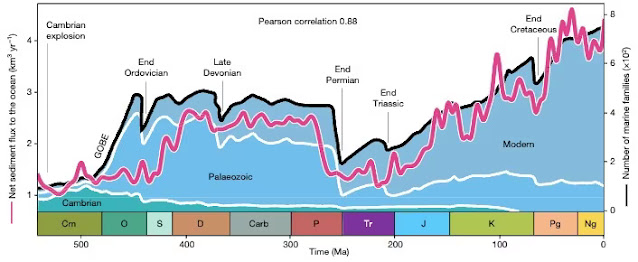今日發表在《自然》(Nature)的新研究顯示從地質時間尺度來看,河川、高山、海洋與沉積物養分的移動過程,是地球生物多樣性演變的主要動力來源。
過去5億4千萬年沉積物進到海洋的通量(粉紅線)vs海洋動物多樣性(黑線)。兩者之間有顯著的相關性(線上標註的為滅絕事件)。圖片來源:《自然》
研究也顯示生物多樣性的演變速率跟板塊運動,也就是塑造陸地、高山、海洋的緩慢地質作用有類似的步調。
「相較於當今人類活動造成的生物滅絕速率,它們顯得無比緩慢,」研究主要作者,雪梨大學地球科學院的Tristan
Salles博士表示。
研究一路追溯地球歷史至五億多年前的寒武紀大爆發不久之後,現今主要的生物類型都在此時確立下來。
Salles博士表示:「地表就像是具有生命力的皮膚一樣。隨著地質時間流逝,河川將地景分割成各式各樣不同環境的棲地,地表也因此演變。」
「然而,這些河川不只能切出峽谷或形成谷地,也是地球循環系統當中的重要環節,因為河川是養分與沉積物從源到匯(山地到海洋)的主要管道。」
「雖然當代科學對於全球生物多樣性了解得越來越多,我們觀看它的方法卻常常是透過狹窄的專家視角,」Salles博士表示。「就像是從一扇窗戶看進一棟房子的內部,就認為對它的格局已經全盤了解一樣。」
「我們的模型以五公里的空間解析度、每五百萬年為一片段,連結物理、化學與生物系統過去五億年來的變化。這讓我們對於驅動物種多樣性時空變化的因素有了前所未有的理解。」
1994年在雪梨西部的藍山一處與世隔絕的峽谷,發現了從古代存活至今的瓦勒邁杉。這是個讓我們看見時間、地質、水文、氣候、遺傳加總起來決定了生物多樣性和物種能否存活的案例。
地景對於地球生命演變的軌跡有所影響的理論可以追溯至德國的自然學家暨博物學家亞歷山大‧馮‧洪堡德。他的成果啟發了查爾斯‧達爾文與阿爾弗雷德‧華萊士,這兩位科學家首先注意到動物種類的分布邊界可以對應到地景的不連續處以及梯度變化。
水與沉積物的通量
「從大約200年前快轉到現在,我們對於過去5億4千萬年海洋與陸地的生命多樣性如何組成還是只有初步的理解,」雪梨大學的博士生Beatriz
Hadler Boggiani表示。
「從化石紀錄以及遺傳學研究可以完好地辨識出生物多樣性的分布模式。但是,生物多樣性的演變過程還有許多方面沒有解答,像是陸上植物擴展與海洋生物迅速多樣化之間為什麼有一億年的時間差。」
在這篇開創性的研究中,由雪梨大學、法國國家研究機構CNRS的ISTerre(法國國家科學研究中心地球科學研究所)以及法國科諾伯勒阿爾卑斯大學組成的團隊提出了一個統合理論,將海洋與陸域的生物演化,跟過往地景控制的沉積物輸送量連結在一起。
「由於地表的演變取決於地圈和大氣圈之間的交互作用,所以它也記下了兩者經年累月的互動過程。而這份紀錄應該可以提供生物多樣性演變的背景脈絡,」科諾伯勒阿爾卑斯大學的Laurent
Husson博士表示。
團隊並非將這道環境謎題中的每一片拼圖分開來各自解決,而是建立一個把全體整合起來的模型,並用高解析度模擬這些作用力集合起來的效應。
「透過以遺傳、化石、氣候、水文、地質構造等形式刻在地球表面上的實體記憶來進行校正,我們得以探討我們的假說,」Salles博士表示。
團隊運用他們三月發表在《科學》(Science)的開源科學碼進行詳細的模擬,接著透過現今量到的地形高度、侵蝕速率、世界主要河川流量以及地質作用運送的沉積物量(也稱作沉積物通量)等資訊來進行校正。
這使得團隊能結合地球化學代用指標並檢驗不同地質構造和氣候的重建結果,藉以評斷他們對過去5億多年進行的估計有多準確。然後這群地球科學家再把預測中的沉積物輸送量,跟彙整古生物資料所得出的海洋及陸域生物演化過程互相比對。
「簡而言之,我們重建了地球自5億4千萬年前開始的顯生元期間的地形變化,並且探討河川網絡、沉積物輸送以及已知的海洋生物和植物的分布模式,三者的演變過程之間有什麼樣的相關性,」科諾伯勒大學的博士生Manon
Lorcery表示。
當他們把估計中進到海洋的沉積物通量跟海洋生物多樣性比較,分析顯示兩者之間有強烈的正相關。
至於陸地,作者設計了一個模型來整合沉積物的覆蓋面積與地景的變異程度,藉此描述地景可以容納多少不同的物種。再一次地,他們發現過去5億4千萬年來這個指標與植物多樣性有非常明顯的相關性。
在1864年出版的小說《地心歷險記》當中,儒勒‧凡爾納透過他虛構出來的主角奧托‧李登布洛克教授表示:
「當地球歷史進入第二章,河流把沉積物土壤堆積下來,取代地球最初章的熾熱岩石之後,此時動物才能開始在地球上生存。」
Salles博士說:「李登布洛克教授向他的姪子阿克塞爾所說的這番觀察跟我們的假說驚人地吻合。儒勒‧凡爾納想必深受洪堡德的研究成果啟發。」
Landscape dynamics determine the
evolution of biodiversity on Earth
Movement of rivers, mountains, oceans and
sediment nutrients at the geological timescale are the central drivers of
Earth’s biodiversity, new research published today in Nature has revealed.
The research also shows that biodiversity evolves at
similar rates to the pace of plate tectonics, the slow geological processes
that drive the shape of continents, mountains and oceans.
“That is a rate incomparably slower than the current
rates of extinction caused by human activity,” said lead author Dr Tristan
Salles from the School of Geosciences.
The research looks back over 500 million years of
Earth’s history to the period just after the Cambrian explosion of life, which
established the main species types of modern life.
Dr Salles said: “Earth’s surface is the living skin
of our planet. Over geological time, this surface evolves with rivers
fragmenting the landscape into an environmentally diverse range of habitats.
“However, these rivers not only carve canyons and
form valleys, but play the role of Earth’s circulatory system as the main
conduits for nutrient and sediment transfer from sources (mountains) to sinks
(oceans).
“While modern science has a growing understanding of
global biodiversity, we tend to view this through the prism of narrow
expertise,” Dr Salles said. “This is like looking inside a house from just one
window and thinking we understand its architecture.
“Our model connects physical, chemical and biological
systems over half a billion years in five-million-year chunks at a resolution
of five kilometres. This gives an unprecedented understanding of what has
driven the shape and timing of species diversity,” he said.
The discovery in 1994 of the ancient Wollemi pine
species in a secluded valley in the Blue Mountains west of Sydney gives us a
glimpse into the holistic role that time, geology, hydrology, climate and
genetics play in biodiversity and species survival.
The idea that landscapes play a role in the
trajectory of life on Earth can be traced back to German naturalist and
polymath Alexander von Humboldt. His work inspired Charles Darwin and Alfred
Wallace, who were the first to note that animal species boundaries correspond
to landscape discontinuities and gradients.
Water and
sediment flux
“Fast forwarding nearly 200 years, our understanding
of how the diversity of marine and terrestrial life was assembled over the past
540 million years is still emerging,” University of Sydney PhD student Beatriz
Hadler Boggiani said.
“Biodiversity patterns are well identified from the
fossil record and genetic studies. Yet, many aspects of this evolution remain
enigmatic, such as the 100 million years delay between the expansion of plants
on continents and the rapid diversification of marine life.”
In groundbreaking research a team of scientists –
from the University of Sydney, ISTerre at the French state research
organisation CNRS and the University of Grenoble Alpes in France – has proposed
a unified theory that connects the evolution of life in the marine and
terrestrial realms to sediment pulses controlled by past landscapes.
“Because the evolution of the Earth’s surface is set
by the interplay between the geosphere and the atmosphere, it records their
cumulative interactions and should, therefore, provide the context for
biodiversity to evolve,” said Dr Laurent Husson from University of Grenoble
Alpes.
Instead of considering isolated pieces of the
environmental puzzle independently, the team developed a model that combines
them and simulates at high resolution the compounding effect of these forces.
“It is through calibration of this physical memory
etched in the Earth’s skin with genetics, fossils, climate, hydrology and
tectonics by which we have investigated our hypothesis,” Dr Salles said.
Using open-source scientific code published by the
team in Science in March, the
detailed simulation was calibrated using modern information about landscape
elevations, erosion rates, major river waters and the geological transport of
sediment (known as sediment flux).
This allowed the team to evaluate their predictions
over 500 million years using a combination of geochemical proxies and testing
different tectonic and climatic reconstructions. The geoscientists then
compared the predicted sediment pulses to the evolution of life in both the
marine and terrestrial realms obtained from a compilation of paleontological
data.
“In a nutshell, we reconstructed Earth landforms over
the Phanerozoic era, which started 540 million years ago, and looked at the
correlations between the evolving river networks, sediment transfers and known
distribution of marine and plant families,” University of Grenoble PhD student Manon
Lorcery said.
When comparing predicted sediment flux into the
oceans with marine biodiversity, the analysis shows a strong, positive
correlation.
On land, the authors designed a model integrating
sediment cover and landscape variability to describe the capacity of the
landscape to host diverse species. Here again, they found a striking
correlation between their proxy and plant diversification for the past 540
million years.
In his 1864 novel A Journey to the Centre of the
Earth, Jules Verne attributes this to his fictitious hero, Professor Otto
Lidenbrock:
“Animal life existed upon the Earth only in the
secondary period, when a sediment of soil had been deposited by the rivers and
taken the place of the incandescent rocks of the primitive period.”
Dr Salles said: “This observation by Professor
Lidenbrock to his nephew Axel fits strikingly well with our hypothesis. So, it
should be no surprise that Jules Verne was greatly inspired by Humboldt’s
work.”
原始論文:Tristan
Salles, Laurent Husson, Manon Lorcery, Beatriz Hadler Boggiani. Landscape
dynamics and the Phanerozoic diversification of the biosphere. Nature,
2023; DOI: 10.1038/s41586-023-06777-z
引用自:University of Sydney. "Landscape dynamics
determine the evolution of biodiversity on Earth."

沒有留言:
張貼留言